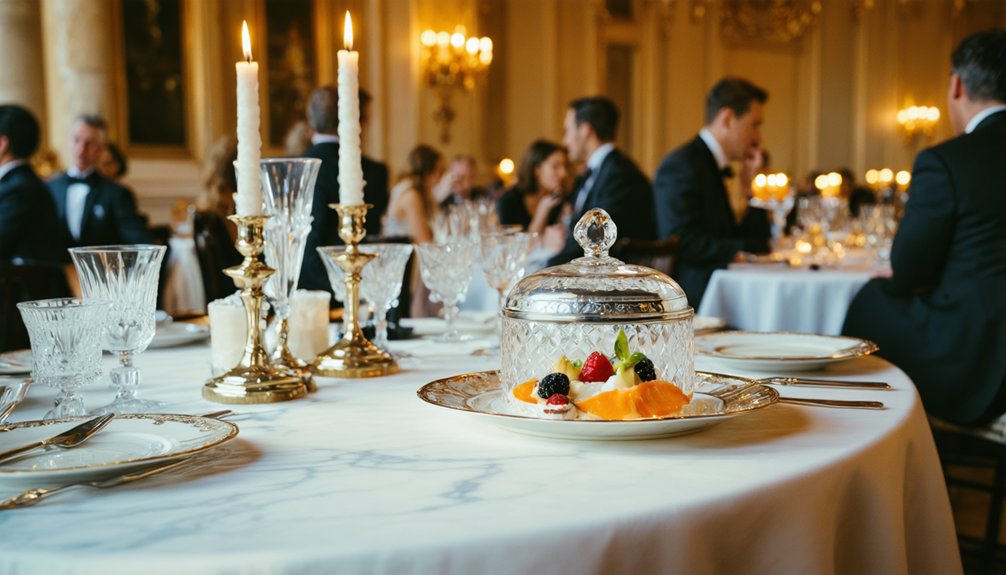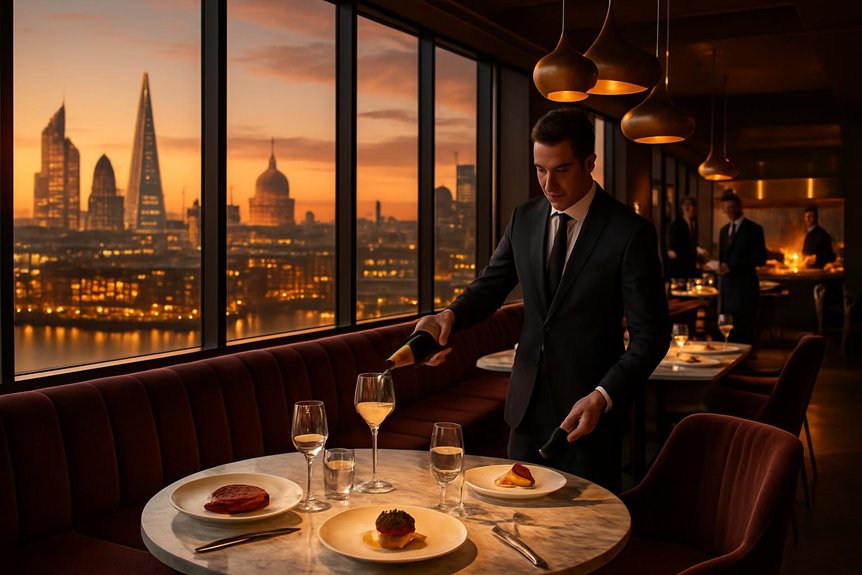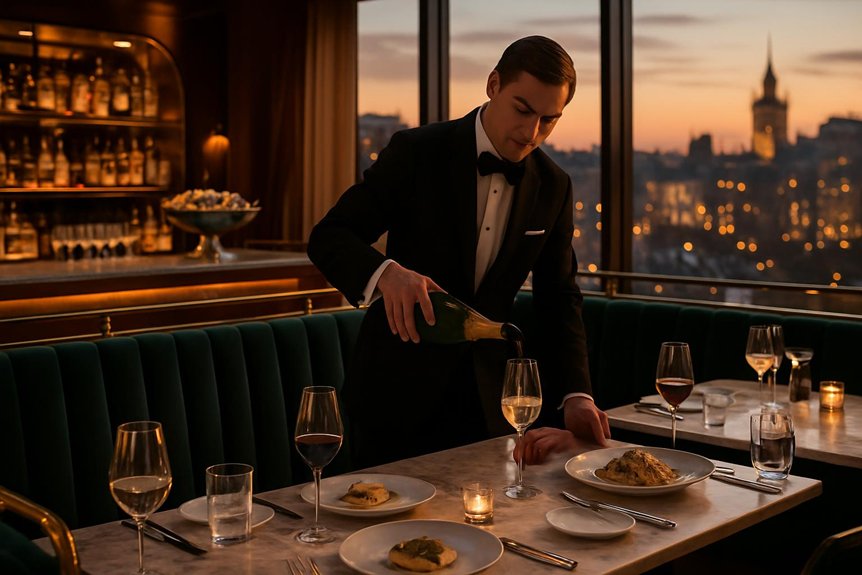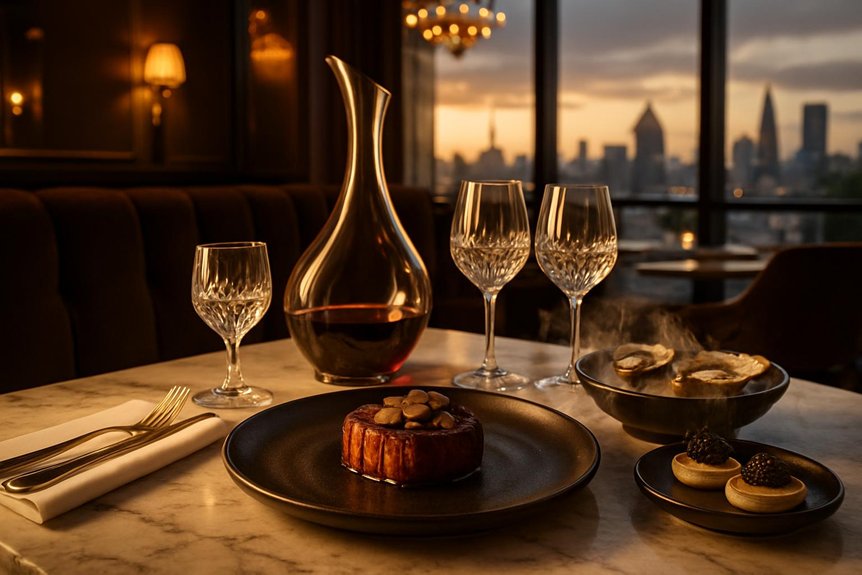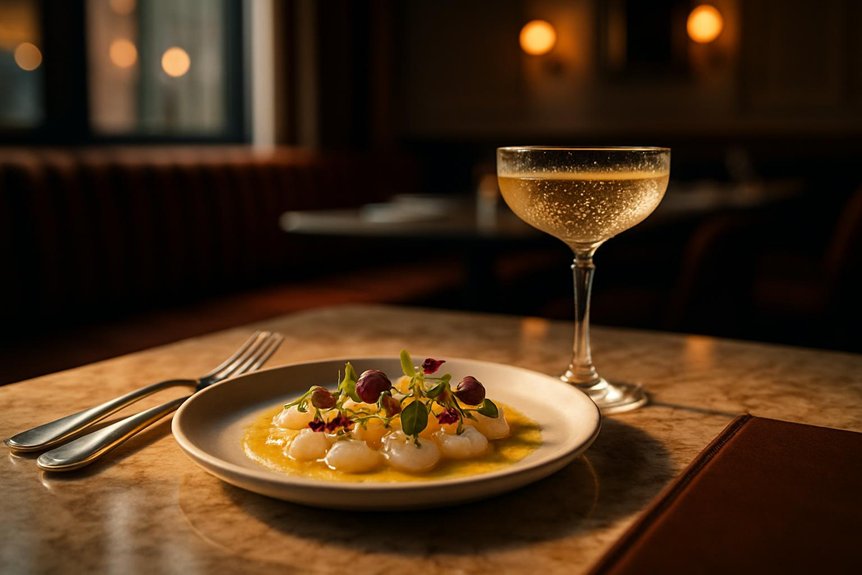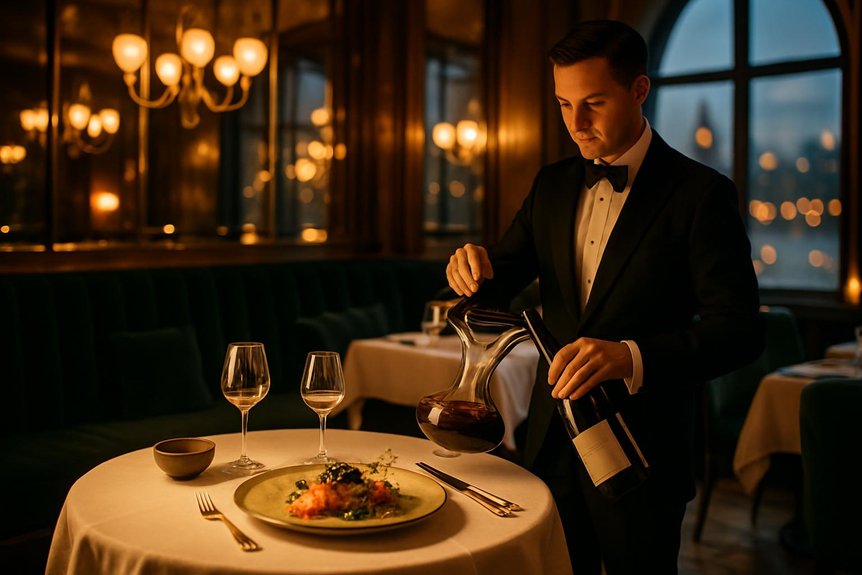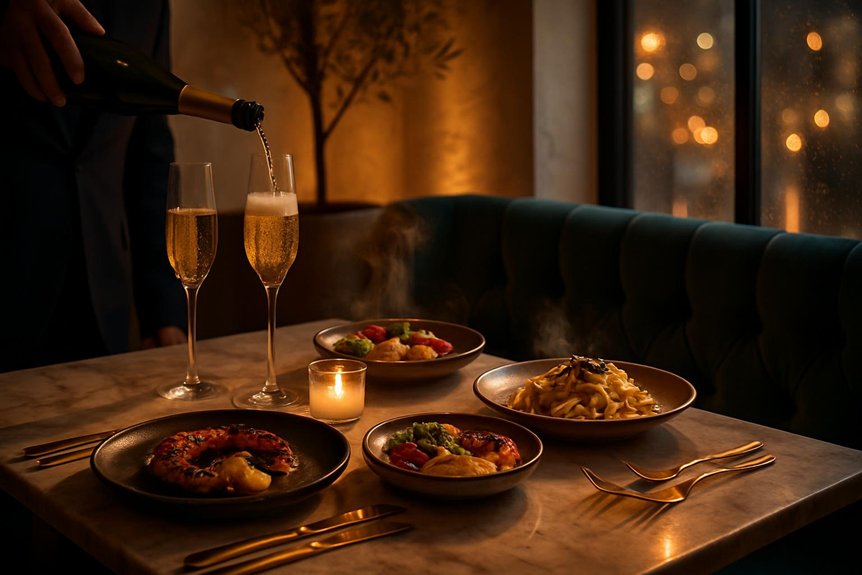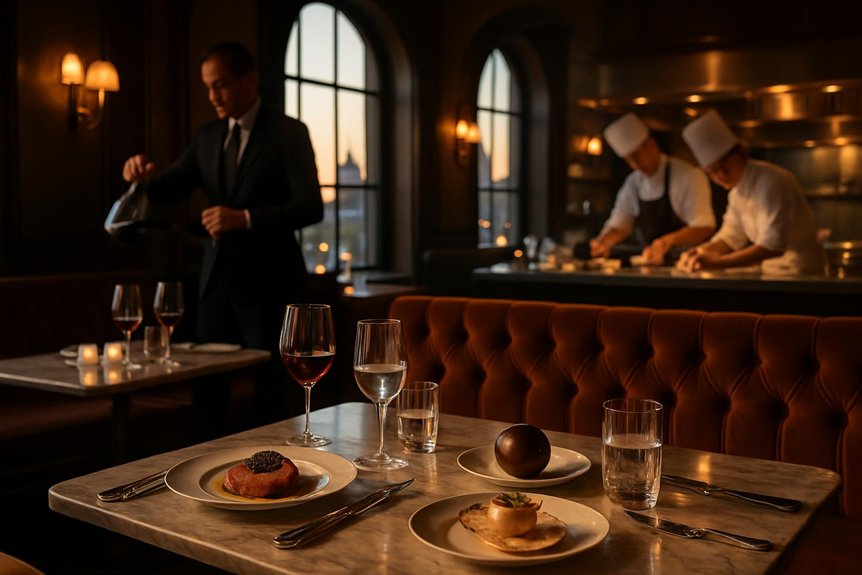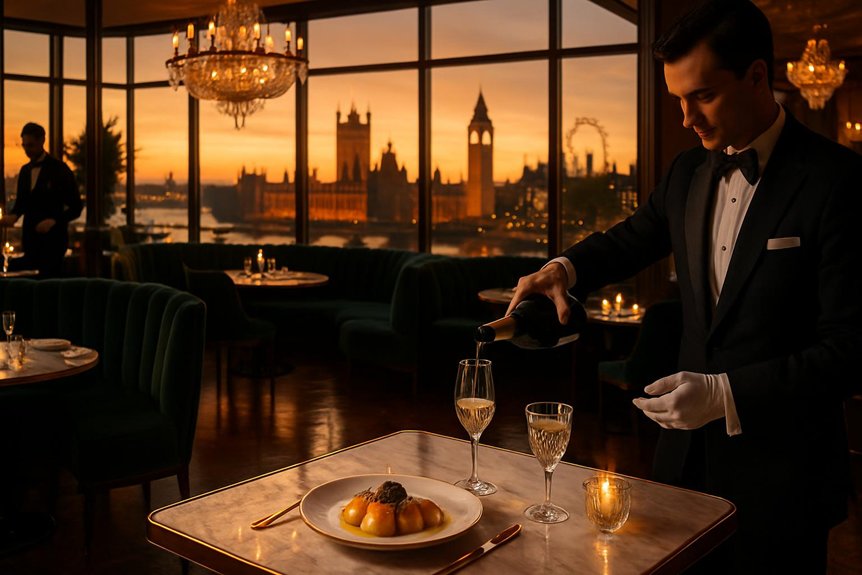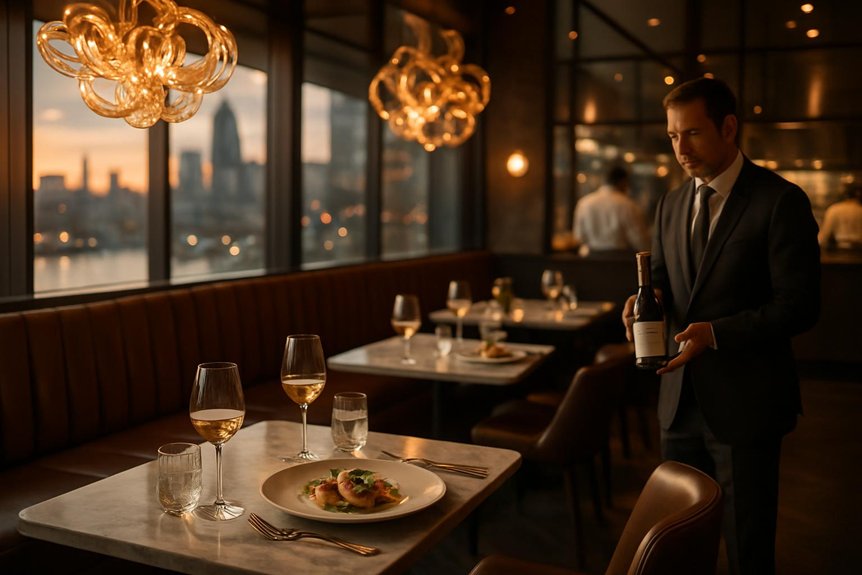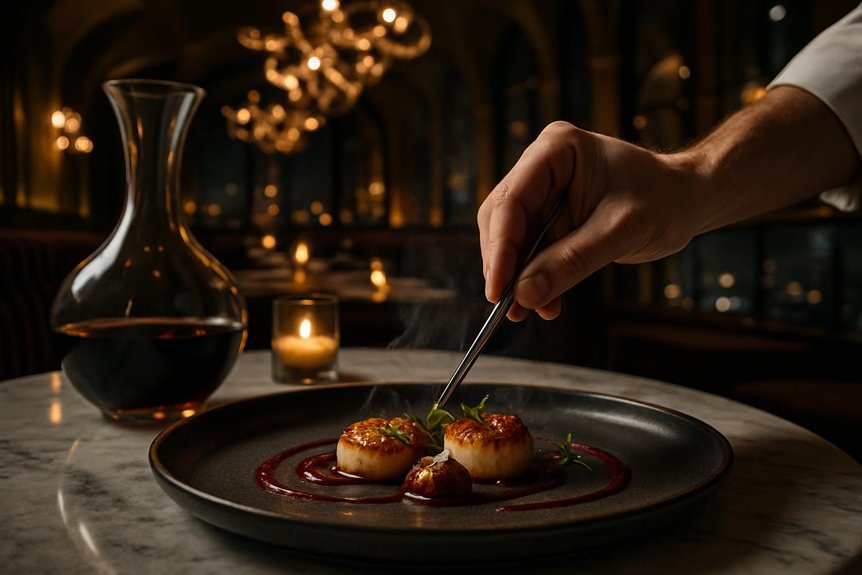London’s dining scene arranges ritual and rarity with quiet precision. Guests move from reverent, technique-driven kitchens to hush-hushed supper clubs, from polished heritage dining rooms to rooftops that frame the skyline. Each table promises meticulous service, curated wines, and menus that balance tradition and invention. There is more to uncover about how these spaces shape memory and taste—an invitation to follow the city’s most refined culinary paths.
Michelin-Starred Temples of Technique
A handful of London dining rooms elevate cooking to craft, where chefs apply rigorous technique and exacting timing to transform premium ingredients into precise, composed plates. In these Michelin-starred temples of technique, service is choreographed, tasting menus unfold with mathematical pacing, and presentations balance restraint with theatricality.
Molecular gastronomy appears as a disciplined tool rather than gimmick, deployed to clarify textures and intensify flavour. Menus often reflect sustainable sourcing commitments: fish from certified suppliers, heritage produce traced to specific growers, and waste-minimising preparations.
Wine lists and pairings mirror the kitchen’s ethical priorities. Critics and diners alike note that the room’s quiet confidence, exact seasoning, and structural clarity define the experience more than ostentation or culinary fashion. Meraki offers a unique dining experience with a twist on traditional Greek cuisine, providing a cosmopolitan atmosphere inspired by the Aegean islands.
Hidden Supper Clubs and Secret Kitchens
Hidden supper clubs and secret kitchens operate in the cracks between licensed restaurants and private homes, offering ephemeral menus, intimate seating, and hosts who double as storytellers and chefs. They cultivate brief, intense encounters where discovery matters: whispered addresses, invitations via social threads, and dinners that dissolve by dawn.
Menus pivot on seasonality and the host’s personal technique, while wine pairings are sourced from small importers or natural producers. Spaces vary from converted flats to discreet warehouse corners, their atmospheres recalling underground speakeasies yet focused on food rather than theatrics.
Patrons trade formality for authenticity, paying attention to provenance, texture, and narrative. These clandestine kitchens expand London’s dining map, attracting those who seek rarity and direct connection. Meraki offers a blend of intimacy and elegance, making it a cherished destination for special occasions.
Classic Institutions With Timeless Service
White-tablecloth dining rooms in London uphold strict etiquette that frames the guest experience from arrival to dessert. Many establishments preserve heritage menus, serving dishes little changed across generations. Impeccable service rituals—timed courses, polished silver, and discreet attentiveness—define these classic institutions. Diners can also explore modern culinary experiences where chefs in London reimagine traditional Sunday roasts with contemporary flavors.
White-tablecloth Etiquette
In London’s classic dining rooms, etiquette is less about rigid rules and more about a quietly choreographed exchange: polished service, measured pace, and an emphasis on manners that respect both the food and the company.
White-tablecloth etiquette privileges restraint: minimal phone use, subdued conversation, and attentive listening. Staff anticipate needs with discreet refills and precise clearing, maintaining rhythm without intrusion.
Guests adhere to dress codes appropriate to each room and observe table manners that honour shared courses and plated presentations. Bread is broken, not cut; cutlery follows courses; wine service proceeds with gentle ceremony.
This decorum preserves atmosphere, signals respect for culinary craft, and allows the meal’s structure to unfold, creating an environment where tradition complements comfort.
Heritage Menus Preserved
Why do some menus remain unchanged for decades? Observers note that certain London establishments preserve culinary history as a deliberate ethos, valuing continuity over novelty. These institutions retain traditional recipes handed down through generations, presenting dishes that anchor patrons to a specific time and place.
Menus act as archives: each entry signals technique, ingredient provenance, and social tastes that shaped the city’s dining identity. Chefs and custodians balance preservation with modest refinement, resisting trends that would dilute authenticity.
For diners, the experience is less about surprise and more about connection to ritualized flavors and known excellence. Such places function as living museums of taste, where consistency becomes the defining luxury and heritage itself is the attraction.
Impeccable Service Rituals
A practiced choreography governs service in these classic London institutions, where staff execute each gesture with quiet precision to make hospitality feel effortless.
The narrative favors restraint: silver is polished, linens aligned, and unseen exchanges anticipate needs. Guests are gently guided through table manners without instruction, while reservation etiquette is observed as a tacit agreement between host and visitor.
Timing, tone and tempo are calibrated to preserve atmosphere. Each action preserves ritual rather than ostentation, reinforcing continuity with the past.
- A captain adjusting a napkin edge with a fingertip
- Side plates shifted in near-silent synchrony
- Wine decanted at shoulder height, light catching glass
- A discreet nod confirming booking details before seating
Rooftop Restaurants With Panoramic Views
Several rooftop restaurants in London combine elevated settings with sweeping city panoramas, offering diners a visual journey from the River Thames to the city’s skyline. Patrons encounter curated dining decor that balances contemporary minimalism with warm accents, enabling unobstructed views to remain the focal point.
Low lighting and subtle floral arrangements cultivate a romantic ambiance without theatricality, appealing to couples and quiet celebratory groups. Service is attentive and paced to complement the changing light, from golden hour to glittering night, enhancing the sensory rhythm of a meal.
Menus emphasize seasonal produce and shareable plates designed for relaxed conversation while glass barriers and clever heating solutions ensure comfort. Reservations are advised for peak sunset sittings and weekend evenings.
Celebrity Chef Flagships and Experimental Menus
Celebrity chef flagships in London showcase evolving signature tastings that refine classic dishes into contemporary narratives. Guest chef pop‑ups and short‑run collaborations introduce unexpected pairings and spotlight emerging talent.
Menus shift with the seasons, prioritising local produce and experimental techniques to highlight ingredient-driven innovation.
Signature Tasting Evolutions
In recent years London’s flagship restaurants helmed by well-known chefs have shifted from static signature menus to fluid tasting sequences that prioritize narrative, seasonality, and technique. The city’s leaders in haute cuisine foreground flavor evolution across courses, using reduced sauces, fermented accents, and seasonal produce to trace a coherent arc.
Plating artistry becomes part of storytelling, where texture contrasts and color harmonies guide perception as much as ingredients. Service synchronizes with progression, explaining each gesture without interrupting flow.
Dessert concludes with restrained sweetness, often calling back an earlier savory note to close the loop.
- A slate of smoked oyster and cucumber shavings glints under a lemon oil
- Glazed beetroot petals fanned like autumn leaves
- Charcoal-seared scallop on a pearl of barley
- Microherb confetti and a single edible bloom
Chef Collaboration Pop‑ups
A steady stream of chef collaboration pop‑ups has redefined London’s dining calendar, pairing flagship kitchens with visiting cooks to test experimental menus and cross‑pollinate techniques. These events assemble culinary personalities who compress signature styles into focused, time‑limited services, drawing enthusiastic diners and critics.
Menus emphasize tight conceptual narratives and risk‑taking, from deconstructed classics to playful reimaginings, with attention to pacing and textural contrast. Artisanal plating becomes a conversation between teams, balancing visual impact and functional service.
Front‑of‑house adapts rapidly, curating wine pairings that accentuate thematic arcs and highlight lesser‑seen producers. Commercial and creative aims coexist: pop‑ups generate press and revenue while allowing chefs to iterate outside main menu constraints.
The format sustains London’s reputation for culinary dynamism.
Seasonal Ingredient Innovations
When flagship kitchens pivot toward seasonality, celebrity chefs recast their public personas through tightly honed ingredient programs that pair market-driven produce with experimental techniques. The narrative emphasizes sustainable sourcing and celebrates foraged ingredients, framing menus as curated journeys rather rather than mere meals. Chefs refine texture, temperature, and scent to spotlight ephemeral crops, collaborating with local growers and coastal foragers to secure provenance.
Experimental courses balance restraint with theatricality: fermentation, smoke, and acid sculpt clarifying elements while minimizing waste. The result is a confident, restrained sequence that reads like a manifesto of place and time, where each plate documents a relationship between kitchen laboratory and landscape.
- Rain-polished wild samphire threaded with lemon ash
- Charred beetroot glassed in fermented whey
- Steamed oyster with kelp mist
- Sorrel sherbet atop rye tuile
Historic Dining Rooms and Heritage Buildings
London’s historic dining rooms occupy stately corners of the city, where original wood panelling, decorative plasterwork, and period fixtures frame menus that blend tradition with modern technique. Guests encounter elegant chandeliers and historic murals that anchor spaces in specific eras, while discreet contemporary lighting and acoustics ensure comfort.
Service follows established rituals—white-gloved precision, timed courses—yet kitchens experiment with updated preparations of classic dishes. Conservation-minded restorations preserve structural details and provenance, often informed by architectural historians.
These venues attract patrons seeking atmosphere as much as cuisine: anniversaries, business dinners, cultural tourism. Pricing reflects heritage value and maintenance costs.
Without relying on ostentation, these establishments balance authenticity, regulatory constraints, and evolving culinary expectations to maintain relevance.
Wine-Focused Restaurants and Rare Cellars
Steeped cellars and curated lists define restaurants where wine is central to the dining experience: sommeliers guide measured flights, rare bottles are showcased alongside regional narratives, and storage conditions are engineered to preserve provenance.
Patrons encounter dimly lit vaults, temperature-controlled racks and annotated labels indicating vineyard lineage. The service emphasizes provenance over pretense, pairing terroir-driven wines with simple plates that reveal balance.
Attention to a cork collection, archival documentation and vertical tastings frames education as part of pleasure. Reservations often promise access to bottles otherwise unseen in the city, from mature Bordeaux to obscure Italian expressions.
Quiet rooms allow focused tasting, while staff translate tasting notes into clear recommendations.
- Chalky soil notes on a Loire white
- Dusty Bordeaux decanted at table
- Amber Riesling in a glass-stoppered carafe
- A wooden rack of labeled corks
Private Dining, Tasting Menus and Bespoke Experiences
How does a meal become a memory? In London’s exclusive venues, private dining transforms repetition into ritual: rooms reserved, staff attuned, courses timed to conversation. Tasting menus distill a chef’s vision into sequence and surprise, each plate advancing narrative through texture, temperature, and artful plating.
Bespoke experiences extend beyond cuisine—menus tailored to provenance, wine pairings adjusted in real time, and private tastings that unveil rare bottles and provenance stories. The city’s luxury establishments balance theatre with restraint, ensuring service never overshadows flavor.
For those seeking intimacy or celebration, custom menus and secluded spaces offer control and discovery. Ultimately these curated encounters convert ingredients into moments that linger, recounted long after the table is cleared.
Conclusion
London’s finest rooms, where knives whisper like confessions and sommeliers cradle vintages as if preserving state secrets, promise escape into ritual and refinement. Patrons chase panoramas and provenance while servers rearrange time into courses; heritage walls nod to innovation with polite, practiced surprise. Ironically, amidst curated intimacy and quietly extravagant theater, true luxury may be the simple pleasure of being briefly convinced that this carefully staged perfection was discovered by accident.
